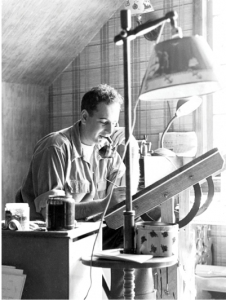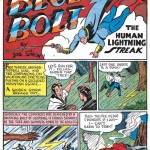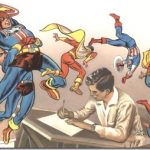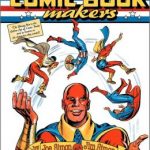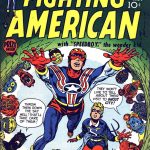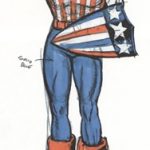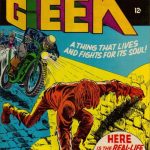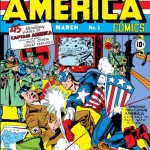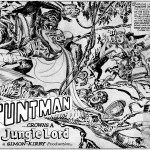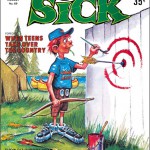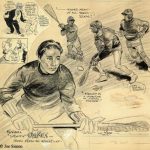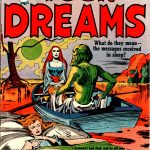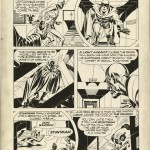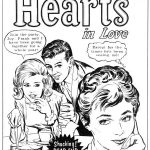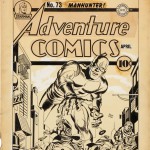Joe Simon was born on October 13, 1912, before the first World War, before movies with sound, and more than two decades before the birth of modern comic books. Over the years he would train himself in various disciplines—including writing, illustration, cartooning, and photography—that would prepare him to be one of the industry’s few true renaissance men.
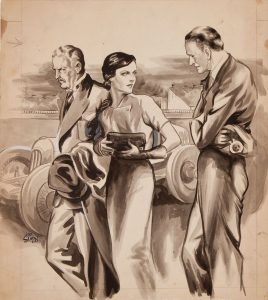
One of the pieces Joe Simon produced in the 1930s to illustrate fiction in the newspapers. © 2014 the Estate of Joseph H. Simon.
Joe’s father, Harry Simon, arrived in the United States in 1905, a clothing maker from Leeds, England. He settled in Rochester, NY, a major U.S. clothing center in the day, and there he married Joe’s mother, Rose. Before long they had a daughter, Beatrice, and soon thereafter a son, Hymie Simon. Joe’s father gave him that name in the hospital, and Rose was furious, refusing to call him anything but “Joseph.” Before long, the name stuck.
An avid reader, Joe devoured the works of Mark Twain, Edgar Rice Burroughs, and Frank Merriwell. Every week he and Beatrice would spread out the newspaper on the floor of the front room, and read the Sunday funnies, including The Gumps by Sidney Smith, Krazy Kat by George Herriman, The Katzenjammer Kids by Rudolph Dirks, Foxy Grandpa by Carl E. Schultze, and Joe’s favorite, Minute Movies by Ed Wheelan.
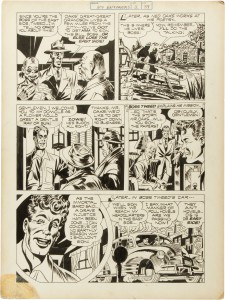
A page from the Runyonesque comic book series “The Vagabond Prince,” written and illustrated by Joe Simon. © 2014 the Estate of Joseph H. Simon.
Young Joe’s art career began in grade school, when he was assigned to draw Christmas pictures on the blackboards. He also produced pencil drawings of cowboys and horses for his fellow students, who paid him a penny or two for each one. By high school he was producing cartoon strips for the school newspaper, and wonderful art deco illustrations for the yearbook. It was during, however, that the Great Depression hit, and forced him to make a difficult decision.
After high school, while many of his classmates went on to college, Joe was determined to get a job to help support his family. His first employer was the Rochester Journal-American, publisher of two Hearst newspapers, where Joe was hired as the assistant to the art director. Under the tutelage Adolph Edler, he proved himself to be a skilled photograph retoucher, cartoonist, photographer, and journalist. When the Rochester newspapers shut down, he moved over to the Syracuse Herald, where he continued to hone his skills.
Among Joe’s most stunning work from this period were some illustrations he produced to accompany fiction that appeared in the newspapers, including detective and Wild West adventures. His composition, brushwork, and shading were both dynamic and elegant.
In Syracuse Joe moved from the Herald to the Syracuse Journal-Telegram, but after a short time that newspaper shut down, as well. So he made another momentous decision—to move to his personal mecca, New York City. There he got work producing commercial illustrations for newspapers and magazines, and an art director at the McFadden Publications suggested that he meet with Lloyd Jacquet of Funnies Incorporated. It seemed there was a new medium beginning to catch fire—a thing called comic books.
Jacquet instantly assigned him to produce a story in its entirety—script, pencils, inks, and lettering, and accepted the first work Joe brought in. Many more followed, including stories that appeared in comics produced by Centaur and Timely. Joe snagged a job as the editor at Fox Comics, where he met Jack Kirby, and their first published story collaboration appeared in Blue Bolt Comics #2, July 1940. Joe moved over to Timely Comics, where he became the first editor for the company that would become Marvel, and Jack followed. There they brought publisher Martin Goodman their first million-seller, Captain America Comics.
Over the years Joe and Jack produced material in every genre—superheroes, science fiction, horror, crime, humor, and war. They created the first romance comic book aimed at teenage girls, thus giving birth to an entire genre within the medium. While the Simon and Kirby Studio employed a varied stable of writers and artists, Joe still penciled and inked many of the stories they produced, including the moody terror of Black Magic, and the Runyonesque adventures of “The Duke of Broadway.” Joe’s weapon of choice was the brush, which he frequently kept “loaded,” enabling him to produce a line of any shape and thickness, as needed.
After the Simon and Kirby team dissolved, Joe continued to develop comics for Harvey Publications, Archie Comics, and DC Comics. For Crestwood Publications he created Sick magazine, the prime competitor to MAD. In comics and commercial art, he continued to produce everything from spot illustrations to paintings that appeared on New York Times magazine supplements.
There’s so much more to the story of Joe Simon that it could fill a book—or more accurately, two books. In 1990 he and his son Jim self-published The Comic Book Makers, and in 2011, at the age of 97, he released Joe Simon: My Life in Comics. A tremendous amount of his output has appeared, as well, in the official Simon and Kirby Library, including The Best of Simon and Kirby. Joe kept working until the very end. In 2007 he could be seen sketching Captain America on CNN, and a little more than a month before he passed away, he attended the New York ComicCon.
Joe’s work was his life, and he conquered every discipline. The history of comics is the history of Joe Simon.
By Stephen W. Saffel, DEO
Senior Acquisitions Editor, Titan Books
(Special thanks to Mike Pascale for providing the files above not counting those with attached captions which are from Stave Saffel’s personal art collection.)

